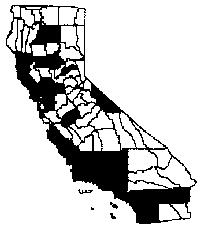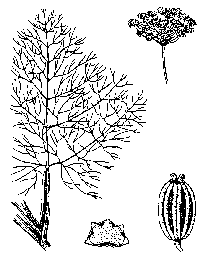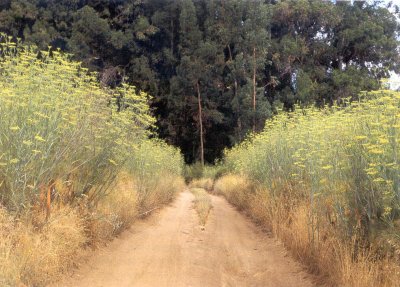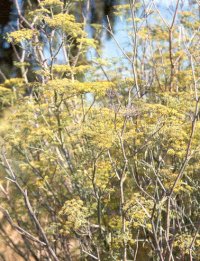|
Foeniculum vulgare
|
|
|
|
Scientific name
|
Foeniculum vulgare
|
|
Additional name information:
|
Miller
|
|
Common name
|
fennel, anise, sweet fennel, aniseed, sweet anise, sweet fennel
|
|
Synonymous scientific names
|
Anethum foeniculum, Foeniculum officinale
|
|
Closely related California natives
|
0
|
|
Closely related California non-natives:
|
0
|
|
Listed
|
CalEPPC List A-1,CDFA nl
|
|
Distribution
|
|
HOW DO I RECOGNIZE IT?
Distinctive features:
|
Fennel (Foeniculum vulgare) is an
erect perennial herb, four to ten feet tall, with finely dissected, almost
feathery leaves and characterized by a strong anise scent originating from stems
and leaves. The flowers are yellow and small (one-quarter inch across), and are
clustered in large, rounded, umbrella-like groups (compound umbels), roughly
four inches across, that are conspicuous from April through July. During the
growing season plants usually include a mixture of living and dead hollow stems
(canes). Branches arise from the stems at conspicuously jointed nodes, and
leaves arise both from the root crown and from the stems. Leaves sheath the
stems where they meet. Seeds of wild fennel look like the fennel seed commonly
used as a flavoring in foods: they are oblong, dorsally compressed, and
ribbed.
åÊ
|
|
Description:
|
| Apiaceae. Perennial herb, 3.3-12 ft (1-3.5 m) high with a characteristic anise or licorice scent. Roots: mature plants have a thick, deep taproot from which erect, solid glaucous-green stems arise. Stems: 10-20 stems originate from a basal cluster in late winter, then die back the following September-November. Leaves: petioles 2.8-5.6 in (7-14 cm) long sheaths hug the stem; leaf blades triangular-ovate in outline and 0.3-2 ft (10-60 cm) long, 1-1.3 ft (30-40 cm) wide, finely dissected into nearly thread-like segments. Inflorescence: compound umbel with 15-40 spreading-ascending rays, each 0.4-1.6 in (1-4 cm) long. |
|
Flowers: no sepals, yellow petals with
narrowing tips, 5 small stamens, inferior ovary topped by two short styles.
Fruits: 0.1-0.2 in (2.5-4.5 mm), oblong-ovate, dorsally compressed, with thick,
prominent ridges.
åÊ
|
|
WHERE WOULD I FIND IT?
|
In California fennel is found in mesic locations with a
Mediterranean climate from sea level to 2,000 feet. It usually colonizes
disturbed areas, especially weedy sites adjacent to fresh or brackish water, and
pastures, abandoned lots, and roadsides. Common in open habitats such as
grasslands, coastal scrub, savannas, and the banks of creeks, estuaries, and
bays. Dense local populations have been reported from Santa Cruz Island, in
fields around the San Francisco Bay region, Palos Verdes Peninsula (Los Angeles
County), and Camp Pendleton (San Diego County). It is widely scattered in fields
and ditches throughout the Sacramento, Salinas, and San Joaquin valleys and
foothills, and in hillside pastures of most coastal counties from Mendocino
south to San Diego. Fennel is particularly aggressive in areas subjected to
plowing or medium-heavy grazing and recently abandoned (Beatty 1991).
Fennel occurs in soils with pH ranging from 4.8 to 8.3, but
appears to prefer more acidic than alkaline conditions. The preferred soil type
appears to be well drained, sandy soils, but it has been observed to thrive in
sites with a high clay content (pers. observation). Fennel forms dense stands in
localized areas (Beatty 1991, Beatty and Licari 1992, R. Klinger, unpubl.
data).
åÊ
|
|
WHERE DID IT COME FROM AND HOW IS IT SPREAD?
|
Fennel is native to southern Europe and the
Mediterranean region, where it has been used for centuries as a spice and for
medicinal purposes (Garland 1979). Although details about its introduction are
unknown, it has occurred in California for at least 120 years and is presumed to
have escaped from cultivation repeatedly (Robbins et al. 1941).
Fennel will reproduce from both root crown and seed. Seeds are
dispersed by water and on vehicles and clothing. Birds and rodents eat the seeds
and may disperse them as well.
åÊ
|
|
WHAT PROBLEMS DOES IT CAUSE?
|
Fennel will invade areas where the soil has been disturbed and
can exclude or prevent reestablishment of native plant species. It can
drastically alter the composition and structure of many plant communities,
including grasslands, coastal scrub, riparian, and wetland communities. It
appears to do this by outcompeting native species for light, nutrients, and
water and perhaps by exuding allelopathic substances that inhibit growth of
other plants (Granath 1992, Colvin 1996, Dash and Gliessman 1994). It develops
dense, uniform stands. On Santa Cruz Island fennel can achieve 50 to 90 percent
absolute cover and reach heights of ten feet (Brenton and Klinger 1994). Once
established, fennel is tenacious and difficult to control. Because of its
prolific seed production and seed viability, a long-lived seedbank can build up
rapidly.
Most impact assessment for fennel has focused on native plants,
but fennelÛªs value to animals is unknown. Grazers will feed on early-season
regrowth, and feral pigs will seek out and eat the roots, but mature stems are
generally not used as food. Birds and rodents eat the seeds.
Fennel stand development and successional patterns are poorly
understood, especially with regard to persistence. It is unclear whether fennel
stands are an edaphic climax, or whether another plant community will replace
them after several decades. In parks and preserves where fennel removal is part
of a restoration program, transitional communities will occur after fennel is
removed, but these may be dominated by other non-native species (Brenton and
Klinger 1994). Klinger and Brenton (in prep. and in review) found there was a
significant increase in native herbaceous species shortly after removal of
fennel, but the areas quickly became dominated by non-native grasses.
åÊ
|
|
HOW DOES IT GROW AND REPRODUCE?
|
Fennel reproduces from both root crowns and
seeds. Flower production generally begins when individuals are eighteen to twenty-four months old. Flowering stems begin to be produced in late winter to early spring, and flowers appear by early May. Seed production is prolific and can begin as early as May and continue through early November. Generally, seed production peaks in August and September. Seeds are dispersed by water, by animals, and by humans by clinging to clothing or mud on vehicles.
Seeds may persist in soil for several years without germinating.
Germination can occur almost any time of the year. Vegetative growth begins in
mid-winter and peaks in July to August. Initial growth during winter and spring
is slow, then becomes rapid in early summer. Flowering stems die during late
fall and early winter, although some remain alive and begin to produce new
leaves with the onset of rains. Plants have a thick taproot.
|
There is little quantitative data on the population biology of fennel. Data on germination rates, seed production, survival, and longevity, density, and viability of the seedbank would be useful for developing management programs.
|
(click on photos to view larger image)
|
|
|
HOW CAN I GET RID OF IT?
|
Little published information is available
on controlling fennel (Brenton and Klinger 1994, Dash and Gliessman 1994).
Management plans should include a survey of where fennel occurs, the current
land use, land use in adjacent areas, anticipated changes in land use, and
primary dispersal mechanisms.
In areas where fennel stands are already well established,
management will require a long-term commitment of time and resources. Management
efforts should focus on preventing or reducing disturbance favorable to further
spread (soil disturbance, moderate to heavy grazing) and reducing fennel density
within dense stands. Dash and Gliessman (1994) reported that non-native species
dominated all areas following fennel control regardless of the technique used.
For these reasons, fennel removal should be considered only a first step in a
larger restoration process that will require other actions to favor
recolonization by native species (Dash and Gliessman 1994). It is probably
impossible to completely eradicate fennel from wildlands, but reducing stand
density and disturbance will minimize its impacts.
åÊ
|
|
Physical control:
|
Manual/mechanical methods: Manual methods are most effective
when infestations are light and locally restricted (Dash and Gliessman 1994).
Digging out individual plants by hand is preferred to plowing or bulldozing
because it minimizes soil disturbance, but it is labor-intensive.
Cutting, mowing, and chopping temporarily reduce the height of
fennel plants within a stand, but they are ineffective as methods of removal and
minimally impact the spread of fennel stands (Dash and Gliessman 1994, Colvin
1996). These techniques leave the roots intact, alive, and ready to support
regrowth of shoots. Repeated cuts may have more impact by helping to exhaust the
resources of the taproot over time. However, intervals between cuts must be
short, because fennel recovers rapidly from cutting and begins to replenish its
root energy supplies (Brenton and Klinger in review, Dash and Gliessman 1994).
Cutting while plants are producing seed will promote dispersal.
Prescribed burning: Experiments on Santa Cruz Island indicate
that burning is not an effective control method by itself (Klinger and Brenton
in prep.). However, fall burns (November-December) followed by herbicide sprays
the following two springs can reduce fennel cover 95 to 100 percent (Klinger and
Brenton in prep.). For reducing fennel in large areas with dense stands, this
method is effective but costly.
åÊ
|
|
Biological control:
|
Insects and fungi: No biological controls
agents for fennel are known.
Grazing: Use of livestock to control fennel will probably be
ineffective except where stands are small, not very dense, and young. In older
and/or dense stands grazing will spread fennel further (Brenton and Klinger
1994). Since fennel can reproduce by roots as well as seed, removal of
above-ground shoots will slow, but not prevent, vegetative spreading. If
livestock are in pastures when fennel is producing seed, they will spread the
seed to new areas. Most heavily infested areas of Santa Cruz Island were
formerly used as cattle pastures (Beatty 1991).
åÊ
|
|
Chemical control:
|
Brenton and Klinger (1994 and in review)
found that 95 to 100 percent kill was achieved when amine and ester formulations
of triclopyr (Garlon 3Aå¨ and Garlon4å¨, respectively) were applied to fennel in
early spring at rates of 6 lbs/100 gallons water (1 lb active ingredient/acre)
on Santa Cruz Island. Lower concentrations (3.0 and 4.5 lbs/100 gallons) of both
the amine and ester formulations were less effective, and all treatments were
less effective when administered in late summer rather than early spring.
Cutting fennel and treating the cut stems did not increase the effectiveness of
the herbicide.
Dash and Gliessman (1994) reported that glyphosate (as Roundupå¨)
sprayed in spring at the manufacturerÛªs recommended rate reduced fennel cover 75
to 80 percent. Cutting prior to spraying did not increase the effectiveness of
the treatments.
åÊ
|




